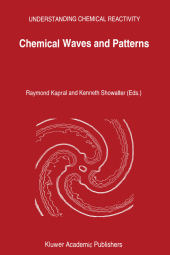 Neuerscheinungen 2012Stand: 2020-01-07 |
Schnellsuche
ISBN/Stichwort/Autor
|
Herderstraße 10
10625 Berlin
Tel.: 030 315 714 16
Fax 030 315 714 14
info@buchspektrum.de |

Raymond Kapral, K. Showalter
(Beteiligte)
Chemical Waves and Patterns
Herausgegeben von Kapral, Raymond; Showalter, K.
1995. 2012. x, 641 S. 2 Tabellen. 240 mm
Verlag/Jahr: SPRINGER NETHERLANDS; SPRINGER, BERLIN 2012
ISBN: 9401045046 (9401045046)
Neue ISBN: 978-9401045049 (9789401045049)
Preis und Lieferzeit: Bitte klicken
The concept of macroscopic waves and patterns developing from chemical reaction coupling with diffusion was presented, apparently for the first time, at the Main Meeting of the Deutsche Bunsengesellschaft fur Angewandte Physikalische Chemie, held in Dresden, Germany from May 21 to 24, 1906. Robert Luther, Director of the Physical Chemistry Laboratory in Leipzig, read his paper on the discovery and analysis of propagating reaction-diffusion fronts in autocatalytic chemical reactions [1, 2]. He presented an equation for the velocity of these new waves, V = a(KDC)1/2, and asserted that they might have features in common with propagating action potentials in nerve cell axons. During the discussion period, a skeptic in the audience voiced his objections to this notion. It was none other than the great physical chemist Walther Nernst, who believed that nerve impulse propagation was far too rapid to be akin to the propagating fronts. He was also not willing to accept Luther´s wave velocity equation without a derivation. Luther stood his ground, saying his equation was "a simple consequence of the corresponding differential equation. " He described several different autocatalytic reactions that exhibit propagating fronts (recommending gelling the solution to prevent convection) and even presented a demonstration: the autocatalytic permanganate oxidation of oxalate was carried out in a test tube with the image of the front projected onto a screen for the audience.
Spiral Waves. Lingering Mysteries about Organizing Centers in the Belousov-Zhabotinsky Medium and its Oregonator Model; A. Winfree. Spiral Wave Dynamics; S. Müller, T. Plesser. A Theory of Rotating Scroll Waves in Excitable Media; J. Tyson, J. Keener. Spiral Waves in Weakly Excitable Media; A.S. Mikhailov, V.S. Zykov. Spiral Meandering; D. Barkley. Spiral and Target Waves in Finite and Discontinuous Media; A.-A. Sepulchre, A. Babloyantz. Turing and Turing-like Patterns. Turing Patterns: from Myth to Reality; J. Boissonade, E. Dulos, P. DeKepper. Onset and Beyond Turing Pattern Formation; Q. Ouyang, H.L. Swinney. The Chemistry behind the First Experimental Chemical Examples of Turing Patterns; I. Lengyel, I.R. Epstein. Turing Bifurcations and Pattern Selection; P. Borckmans, G. Dewel, A. De Witt, D. Walgraef. The Differential Flow Instabilities; M. Menzinger, A. Rovinsky. Chemical Wave Dynamics. Wave Propagation and Pattern Formation in Nonuniform Reaction-Diffusion Systems; A. Zhabotinsky. Chemical Front Propagation: Initiation and Stability; E. Mori, X. Chu, J. Ross. Pattern Formation on Catalytic Surfaces; M. Eiswirth, G. Ertl. Simple and Complex Reaction-Diffusion Fronts; S.K. Scott, K. Showalter. Modeling Front Pattern Formation and Intermittent Bursting Phenomena in the Couette Flow Reactor; A. Arneodo, J. Elegaray. Fluctuations and Chemical Waves. Probabilistic Approach to Chemical Instabilities and Chaos; G. Nicolis, F. Baras, P. Geysermans, P. Peeters. Internal Noise, Oscillations, Chaos and Chemical Patterns; R. Kapral, X.-G. Wu. Index.


